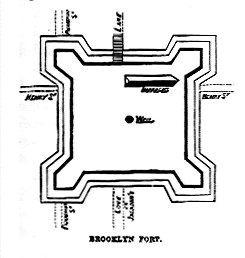
HISTORY OF BROOKLYN. 315
It is said to have been an exciting and exceedingly interesting sight to witness several thousand men, soldiers, mechanics, farmers, and laborers, all busily engaged in erecting this extensive fortification, on lands which, a few months previous, had been covered only with thrifty orchards, under whose grateful shades cattle quietly grazed or reposed. Nature had yielded to the rude hand of war; but years have again passed, and the same locality, under the inspiration of modern civilization, has experienced a still more marvellous change; so that the stranger who walks our thickly populated streets, can scarcely realize that he treads upon “Revolutionary ground.”

This fort was 450 feet square, with ramparts rising about forty or fifty feet above the bottom of the surrounding ditch, itself twenty feet in depth.(1) At the an-gles of the fort were bastions, on each of which
weight, having a quantity of iron work about it, yet so admirably constructed as to be easily raised and lowered by one person. Besides these, some forty workmen were employed in digging a well, in the exact oentre of the fort—an undertaking of great labor and expense. Furman’s MSS. says: “So deep were they obliged to go for water, that they almost despaired of ever finding it, but reached it finally. It is stoned with freestone, regularly cut, and is probably the best constructed and most expensive well on the island, if not in the State, and is now used as a public well, a pump having been put in it for the upper part of Henry street. It was built by a man named Schofield, who received a guinea a day for superintending it. Schofield commenced the job a poor laboring man, working himself; but before long he wore ruffles to his shirt, and hired laborers to carry on the work, which, however, was well done.” Under date of August 23, 1823, Furman’s MSS. “record the frame of the first building erected on the site of the old British fort, through which Jackson’s, alias Love Lane, passes, put up this day on Henry street. It is to be a two-story wooden dwelling house, about thirty feet broad and fifty feet deep, owned by Samuel Jackson, Esq. At this time there are no houses south of Cranberry street.” The well in said fort ̉has not been used since the evacuation, in 1783. It is now cleaned out, and a wellhouse built over it, for the purpose of supplying the above-mentioned house with water. Considerable part of the remains of the fort has been levelled within a year or two.”
1 In the earlier village days, these ditches of the old fort furnished an excellent place for target-firing, which was frequently practised there by the citizen soldiery.